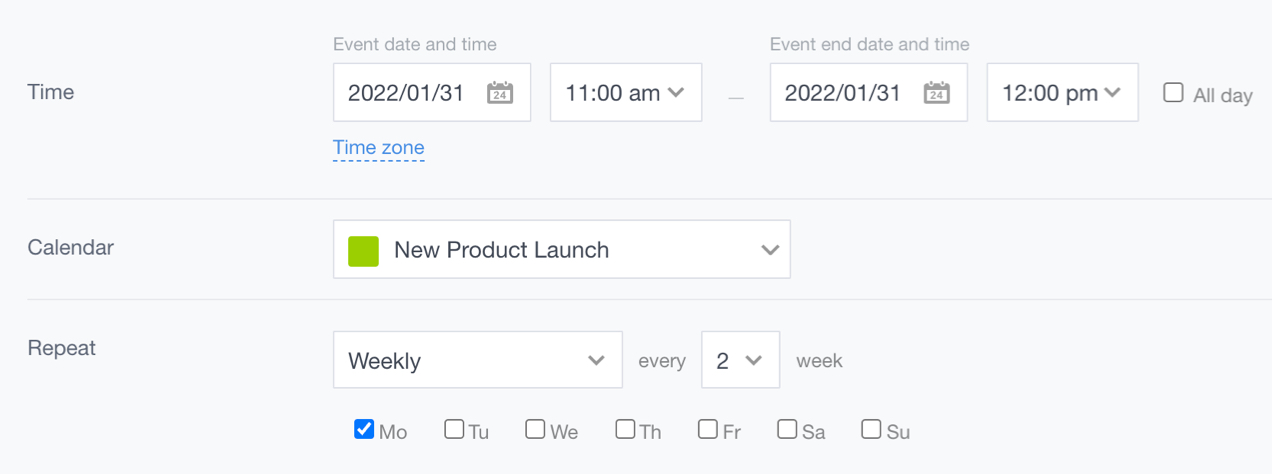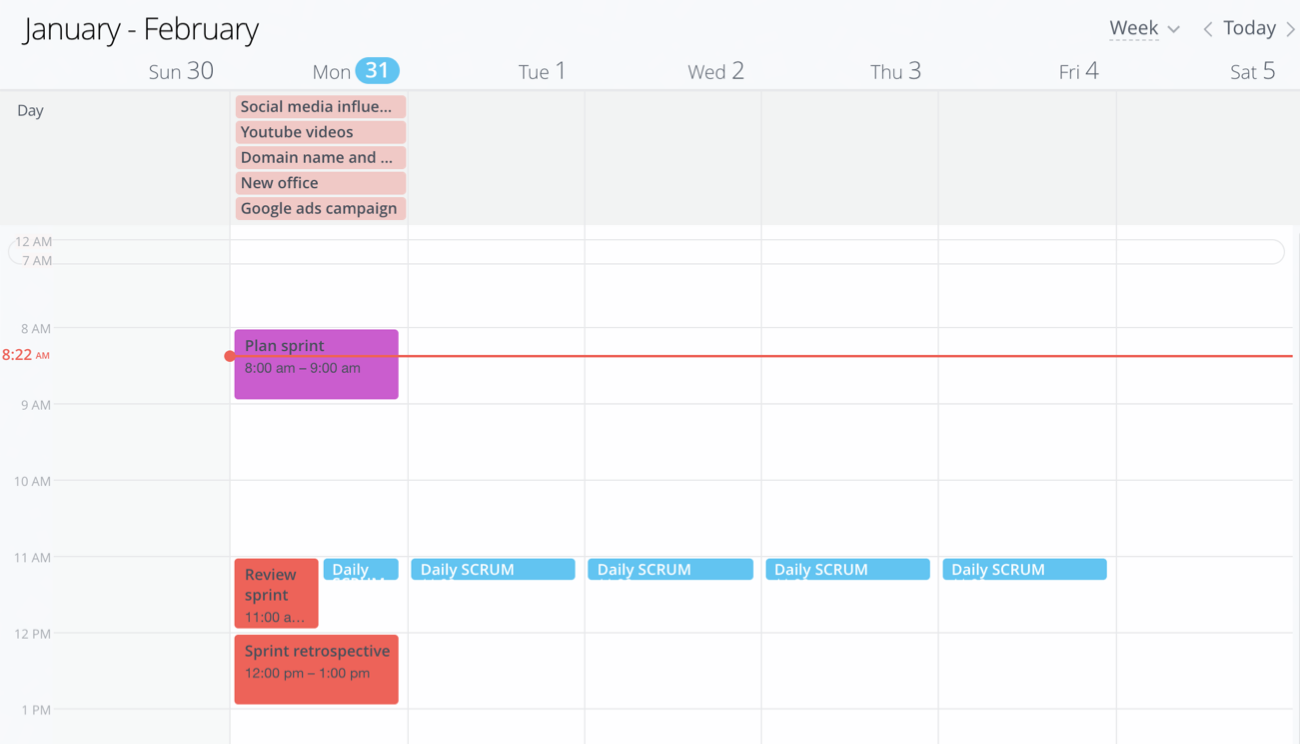Using Scrum in Bitrix24 is easy
1 min 22 sec
Bitrix24 features a full set of Scrum tools
-
Whether you work remotely or in the office, or both (the so-called “hybrid work model”), you will find it easy to use Scrum in Bitrix24, including event scheduling, chats, and online meetings.
Being an all-in-one solution, Bitrix24 easily replaces any other communication or collaboration tools you might be using, allowing you to stay in touch with your team 24/7 from any device - mobile or desktop.
- Bitrix24 was originally designed as an online workspace, which means your whole company can use it to communicate, collaborate on documents, manage clients, sales, projects, and so much more.
- Not everyone has to use Scrum in your company. Certain teams can keep working the same way they did before while still being a part of the same environment with the Scrum teams inside Bitrix24.
So, you’ve got your team together, laid down the basics, and explained to them all the benefits of using Scrum in Bitrix24. Now, let’s get down to work! Let’s do it!

Alexander Polozhevets
Your Bitrix24 Scrum advisor
Step 1. Create a Scrum team
Here’s what you have to do:
- Head over to the Tasks and projects section of the main menu, open the Scrum tab and click Create.
- Type in the name of your team, choose the visual theme and add an icon.
-
Set the privacy level - is your Scrum team going to be visible to everyone else in the company?
A popular choice is to make the team Private. This way, your team will be still visible to everyone else in your Bitrix24 account but people won’t be able to access it without receiving an invitation first.
- The final step is inviting your team members.
Creating a Scrum team in Bitrix24
1 min 17 sec
There are several key roles in a Scrum team
-
Product owner
Product owner is like a general manager. This person defines the scope of work and prioritizes the tasks. As a rule, the product owner does not work on tasks per se (that’s what the team is for).
It’s more of a managerial position similar to a department head. You can have only one product owner in Scrum.
-
Scrum master
Scrum master is essentially a coordinator. This person’s job is to make sure a Scrum team is operating as effectively as possible with Scrum values. This means keeping the team on track, facilitating daily meetings, and working out any obstacles the team might face.
However, not every Scrum team requires a Scrum master. In certain cases, the product owner can also assume the role of the Scrum master.
-
Development team
These are the people who do the hands-on work of completing the tasks. -
Stakeholders
Basically, everyone else. These could be people who take part in certain tasks as consultants or those who accept the final result. They can view tasks but cannot edit them.
Example
General tasks
Here, Scrum is used for stable and steady growth achieved in small iterations.
The roles:
- Product owner - the company’s manager or department head.
- Scrum master - a dedicated specialist or the company’s manager.
- Development team - the company’s employees.
- Stakeholders - these could be people who take part in certain tasks as consultants or those who accept the final result.
Example
IT projects
This is a classic example of Scrum in action.
The roles are as follows:
- Product owner - the product manager.
- Scrum master here is often a certified specialist who fully assumes this role. It could be a technical lead, CTO, or any other specialist with a deep understanding of the development process. Someone who can earn the utmost respect and trust from the team.
- Development team - people who do the hands-on work of completing the tasks.
- Stakeholders - either the company’s clients or internal stakeholders (if the company develops its own products).
Example
Creative teams
Here, the team usually has to work on rather long projects that involve a creative approach.
The roles are as follows:
- Product owner - the project manager.
- Scrum master - this could be either the project manager (if he/she knows enough about Scrum) or a dedicated specialist.
- Development team - people who do the hands-on work of completing the tasks.
- Stakeholders - either the company’s clients or internal stakeholders (if the company develops its own products).
Example
Complex tasks
This could be a cross-functional team or dedicated specialists from certain department(s).
The roles are as follows:
- Product owner - the team lead who oversees the process of completing a task.
- Scrum master - a dedicated specialist (internal or external) or the team lead.
- Development team - people who do the hands-on work of completing the tasks.
- Stakeholders - top management, middle managers responsible for certain KPIs or processes that the Scrum team is also involved in.
Step 2. Create meetings and chats
If you don’t want your team to be late for meetings, let’s schedule them in the calendar.
In Bitrix24 Scrum team settings, you can choose from 4 types of meetings. Just set the time and it’s done!
Creating a meeting
2 min 15 sec
If your team is working in 2-week sprints:
-
Sprint planning
Typically held on Mondays, you can schedule this meeting and set it to repeat every two weeks.
Let’s say we want to have our sprint planning meeting from 11 to 12 in the morning because we’re going to need earlier hours for other events=)

-
Daily Scrum meeting
A quick, 15-minute meeting during which every team member has to say what they did yesterday, what they’re going to do today, and if there are any problems.
Let’s set this meeting for 9:00 and move on.
Worth noting
Whether you use Scrum or not, getting your team together for a quick discussion in the morning is a great way to make sure everyone’s on the same page and collect valuable feedback from the team.
It allows you, as the manager, to keep your finger on the pulse and see how your team is doing on a daily basis.
If you’re working remotely, you can have your daily Scrum meetings in the format of a video conference.
-
Sprint review
This meeting is used to showcase a live demonstration of the work completed. Typically, it is held after another 2-week sprint is finished, on Monday.
Let’s set the sprint review meeting from 10:00 to 11:00, right before the daily planning meeting, to keep the momentum going.
-
Sprint retrospective
This meeting is held to facilitate a team’s reflection on their progress. The team speaks openly about their organizational concerns and work issues that arose during the sprint. Typically, a retrospective meeting is held the same day as the sprint review.
Let’s set it from 12:30 to 1:00, after the review and planning meetings.
Once you’ve added all these meetings to the calendar, all your team members will be automatically invited to them and receive reminders before each meeting.

The team moves at a steady, predictable pace: every two weeks on Monday, there’s a sprint review meeting, after which the team plans tasks for the next sprint and discusses the potential improvements to the overall working process. After that, it’s another two weeks of productive work interrupted only by quick daily meetings.
Bitrix24 automatically creates a chat for every meeting.
The team can quickly discuss work-related issues and have online meetings right inside Bitrix24.
Step 3. Add tasks and activities to the backlog
Transfer all your tasks, wherever you have them now - written down on a piece of paper, in a text document on your computer, or your smartphone notes - into a single backlog because that’s where they belong.
Any new ideas you might have along the way, just add them to the backlog as well.
Any team member should have access to the backlog.
Adding tasks to the backlog
1 min 41 sec
When adding tasks to the backlog, you can provide some additional information or context by grouping these tasks into epics for easier and faster navigation.
Using a different color for every epic will make it even easier to find them.
Example
General tasks
Here’s the kind of tasks you might have in your backlog:
- Sales-related: create new sales call scripts, handle customer complaints, analyze customer feedback.
- Marketing-related: launch a TikTok business account, come up with a new SMM strategy, etc.
- Strategic tasks: launching a new product/service or rebranding.
The potential epics you could use are Marketing, Sales, Strategic Development, and so on.
Example
IT projects
When a software development team works on a product, the backlog is usually full of different ideas, suggestions, and improvements. The product manager is usually the one to prioritize these items.
Epics can help you group the backlog items into meaningful categories, such as Usability, Conversion Rate, UI Improvements, and so on.
Sometimes, it makes perfect sense to single out a particularly big task (like product redesign) and make it an epic. This way, you will be able to keep creating different subtasks within this epic that will be enough to keep your team busy for a few sprints.
Example
Creative teams
When working on a long, creative project, the team is bound to have a considerable number of ideas and activities:)
The backlog may include items like tasks and suggestions from both the client and the team.
Here, epics can help you to group similar tasks into meaningful categories for easier navigation. This way, you will be able to quickly put together tasks for the next sprint or draw inspiration for another project.
Example
Complex tasks
When a team is constantly brainstorming and testing out new ideas, some of them might get lost in the shuffle.
Keeping all of these ideas in the backlog will help you to access them easily and make sure there are no duplicates.
Now that your backlog is filled with great ideas and ambitious tasks, it’s time to invite your Scrum team to discuss them in the chat and maybe add a few more!

Step 4. Set the DODs (Definition of Done) for your tasks
Although you can start using Scrum without DODs, it is still recommended that you use them.
The main idea behind the Definition of Done is that every team should have a clear understanding of when a task can be considered complete without having to consult with the Product Owner first.
Definition of Done
1 min 19 sec
Without clear task completion criteria, the process of accepting a supposedly completed task may turn into a long and often pointless discussion.
Having a Definition of Done solves this problem perfectly and eliminates your involvement in the task acceptance process.
You can have multiple DODs for various types of tasks since the completion criteria will obviously differ. When adding a task to the backlog, you can provide the DOD for this task.
Example
General tasks
You can use a checklist for tasks related to business development to make sure none of the important details are missed.
For example, update the information on your website, send out a memo to your colleagues, get approval from the legal department, update the documentation, and so on.
Example
IT projects
When a software development team is working on a project, the task completion criteria are usually quite specific.
E.g., test the product after every change in the code, prepare marketing announcements in 18 languages before every update, and so on.
Example
Creative projects
“Creative” does not have to mean “chaotic”. Here, your can create DODs for file formats, saving copies of documents, or other things.
Example
Complex projects
Here, the main DOD is usually to formulate the final result of an experiment and share it with the stakeholders.
If you’re planning to actually implement the results of an experiment, you may want to schedule a demo for your colleagues, prepare instructions, and so on.
Good job!
Now you know enough to get started with Scrum in your company. It’s time to get out there and start your first sprint!
We are going to talk more about this in our next section.

Advanced settings
- Read more about using Calendar here.
- Sync your Bitrix24 Calendar with the calendar on your smartphone to keep track of your Scrum team events wherever you are. Here’s how you do it.
Self-check time
What makes Bitrix24 an easy and convenient Scrum tool?
Select one or more correct answers:
Where is Scrum located in Bitrix24?
Select answer
Which of these descriptions can be attributed to the Scrum Master?
Select one or more correct answers:
Which of these descriptions can be attributed to the backlog in Scrum?
Select one or more correct answers:



